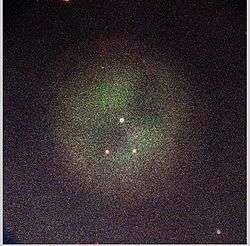< Messier Index

| Owl Nebula | |
|---|---|
| Observation data (Epoch J2000.0) | |
| Right ascension | 11h 14.8m |
| Declination | +55° 01′ |
| Distance | 2,600 ly |
| Apparent magnitude (V) | +9.9 |
| Apparent dimensions (V) | 3.4 × 3.3 arcmin |
| Constellation | Ursa Major |
| Physical characteristics | |
| Radius | 1.5 ly |
| Absolute magnitude (V) | - |
| Notable features | Owl-like "eyes" visible through larger telescopes |
| Other designations | M97, NGC 3587 |
The Owl Nebula (also known as w:Messier Object 97 or NGC 3587) is a w:planetary nebula in the w:constellation w:Ursa Major. It was discovered by w:Pierre Méchain in 1781.
M97 is regarded as one of the more complex of the planetaries. The 16th magnitude central w:star has about 0.7 w:solar mass and the nebula itself about 0.15 solar mass. The nebula formed roughly 6,000 years ago.
The nebula gets it name due to the appearance of owl-like "eyes" when view through a large (>200 mm) telescope under dark sky conditions with the aid of a so-called "nebula filter." The "eyes" are also easily visible through photographs taken of the nebula.

Image of Messier 97 taken with red, green
and blue filters with the w:Faulkes Telescope North
and blue filters with the w:Faulkes Telescope North
External links
- The Owl Nebula @ SEDS Messier pages
- NightSkyInfo.com - M97, the Owl Nebula
- M97, imaged with a semiprofessional amateur-telescope
| |||||
This article is issued from
Wikibooks.
The text is licensed under Creative
Commons - Attribution - Sharealike.
Additional terms may apply for the media files.